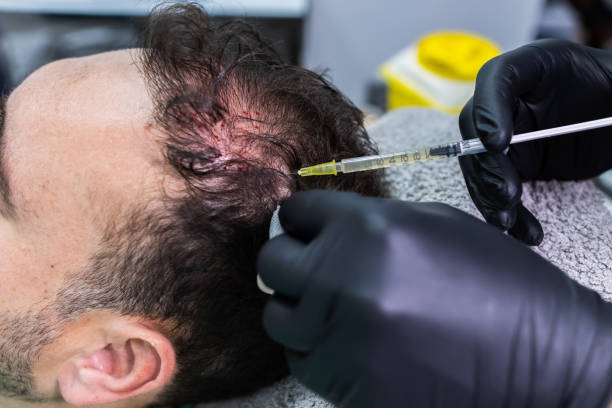PRP Hair Treatment: A Revolutionary Approach to Hair Loss

Hair loss is a common issue that affects millions of people worldwide, often leading to diminished self-esteem and confidence. Traditional treatments like medications and hair transplants have long been popular solutions, but a newer, less invasive option called Platelet-Rich Plasma (PRP) hair treatment is gaining traction. This innovative therapy leverages the body’s natural healing abilities to stimulate hair growth. Let’s explore what PRP hair treatment is, how it works, and what patients can expect.
Understanding PRP Hair Treatment
Platelet-Rich Plasma (PRP) therapy is a medical procedure that uses a concentration of platelets derived from the patient’s own blood to rejuvenate hair follicles and promote hair growth. The process involves three main steps:
- Blood Draw: A small amount of blood is drawn from the patient’s arm.
- Centrifugation: The blood sample is placed in a centrifuge, which spins at high speed to separate the plasma rich in platelets from other blood components.
- Injection: The concentrated PRP is injected into the scalp where hair thinning or loss is evident.
PRP is rich in growth factors and proteins essential for tissue repair and regeneration, making it an effective treatment for hair loss.
How PRP Stimulates Hair Growth
The effectiveness of PRP in hair restoration lies in the growth factors it contains. When injected into the scalp, these growth factors:
- Revitalize Hair Follicles: PRP stimulates dormant hair follicles to transition into the active growth phase.
- Enhance Blood Circulation: Improved blood flow to the scalp nourishes hair follicles, promoting healthier and stronger hair.
- Boost Cellular Functions: Growth factors boost cellular activities, including the proliferation of dermal papilla cells, which are crucial for hair growth.
- Reduce Inflammation: PRP’s anti-inflammatory properties help mitigate conditions like androgenetic alopecia and alopecia areata, which contribute to hair loss.
The PRP Treatment Process
PRP hair treatment is a minimally invasive procedure performed in a clinical setting. Here’s a detailed look at the steps involved:
- Consultation: The process begins with a thorough consultation to assess hair loss patterns and determine suitability for PRP therapy.
- Preparation: On the day of the procedure, a small amount of blood is drawn from the patient.
- Centrifugation: The blood is processed in a centrifuge to extract the PRP.
- Injection: The PRP is meticulously injected into the scalp at the level of the hair follicles using a fine needle. The number of injections depends on the extent of hair loss and the area being treated.
Expected Results and Recovery
PRP therapy is typically administered in a series of sessions spaced about a month apart. Initial results, such as reduced hair shedding and increased hair thickness, can often be seen within three to six months. However, individual results may vary based on factors like the severity of hair loss and the patient’s overall health.
Recovery from PRP hair treatment is quick, with most patients experiencing minor discomfort at the injection sites, such as redness or soreness, which usually resolves within a day or two. As a non-surgical procedure, PRP doesn’t entail the risks or extended downtime associated with more invasive treatments.
Ideal Candidates for PRP Hair Treatment
PRP hair treatment is suitable for both men and women experiencing early-stage hair loss or thinning. It’s particularly effective for individuals with androgenetic alopecia (pattern hair loss) but can also benefit those with other types of hair loss. However, it may not be suitable for individuals with certain medical conditions, such as:
- Blood disorders
- Chronic liver disease
- Active infections
A thorough evaluation by a healthcare professional is essential to determine if PRP therapy is right for you.
Advantages of PRP Hair Treatment
PRP hair treatment offers numerous benefits:
- Natural Solution: As it uses the patient’s own blood, PRP minimizes the risk of allergic reactions and adverse effects.
- Minimally Invasive: The procedure is non-surgical and relatively painless, with minimal downtime.
- Convenience: Treatment sessions are short, usually lasting less than an hour.
- Complementary Therapy: PRP can be used alongside other hair loss treatments, such as medications or hair transplants, to enhance results.
The Future of PRP in Hair Restoration
Research into PRP therapy is ongoing, with studies exploring its potential in conjunction with other regenerative treatments. Advances in PRP preparation techniques and a better understanding of its mechanisms may further improve its efficacy and broaden its applications in hair restoration.
Conclusion
PRP hair treatment stands out as a promising and innovative solution for those struggling with hair loss. By leveraging the body’s natural healing processes, PRP offers a safe, effective, and minimally invasive option for rejuvenating hair growth and restoring confidence. If you’re considering a treatment for hair loss, consulting with a qualified healthcare provider about PRP therapy could be your first step toward achieving healthier, fuller hair.










